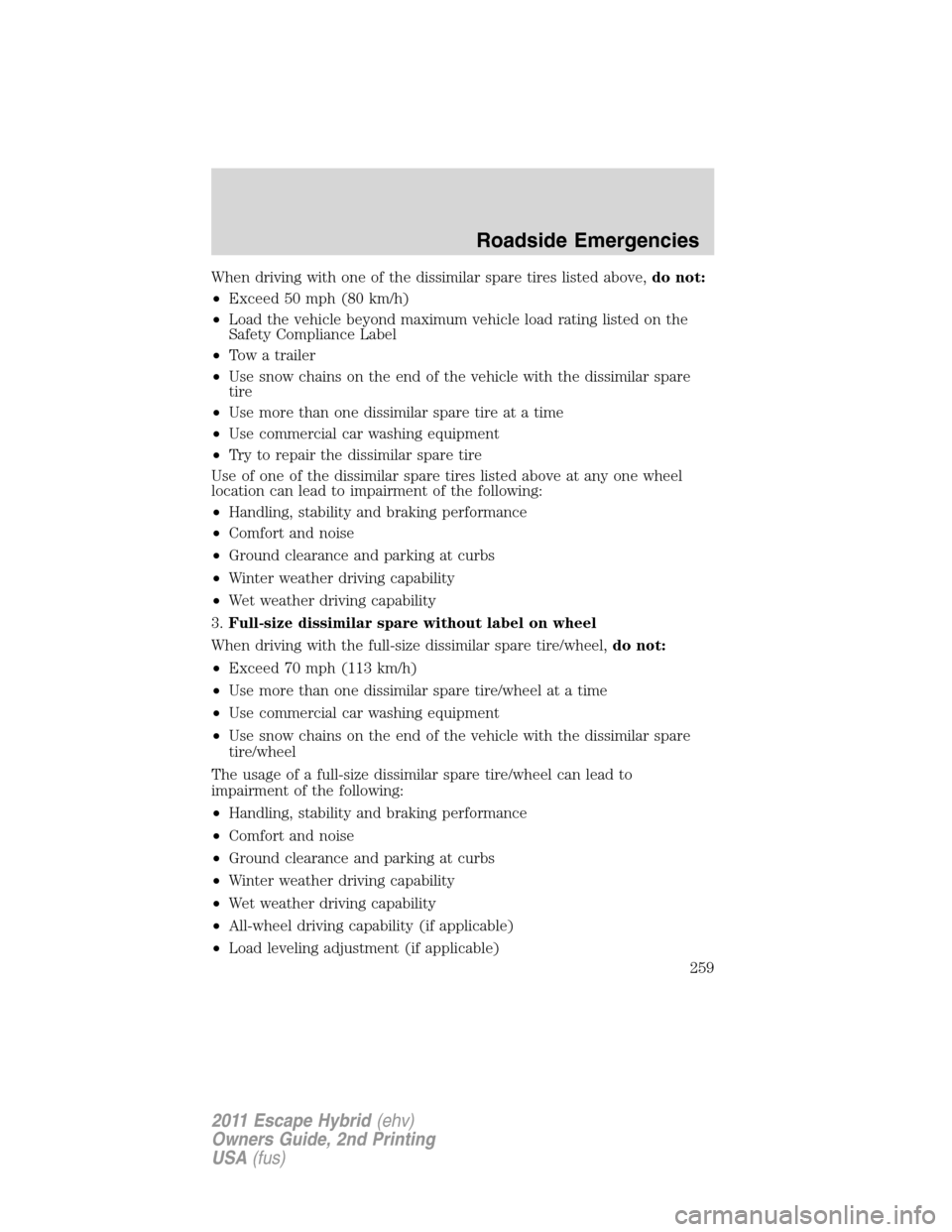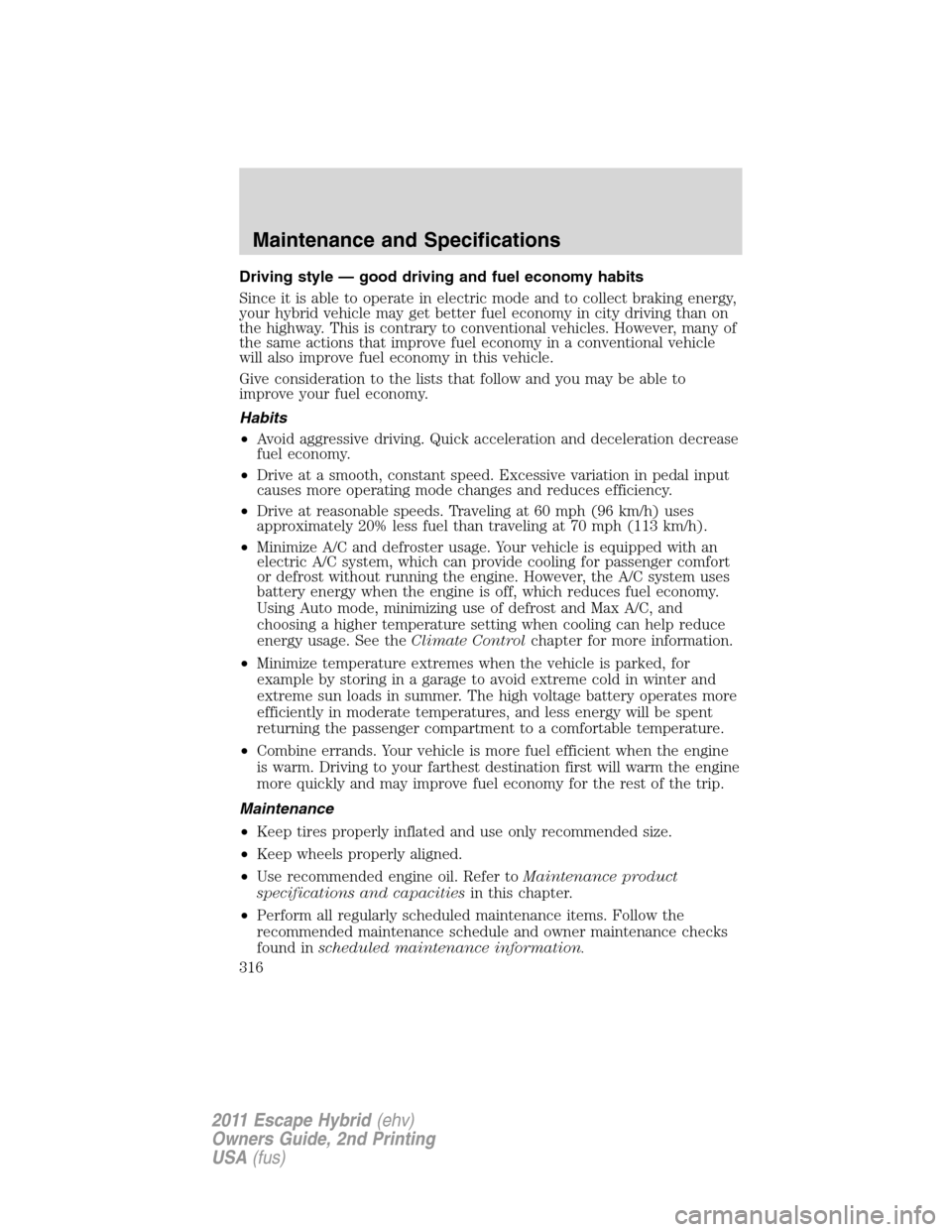winter tires FORD ESCAPE HYBRID 2011 2.G Owners Manual
[x] Cancel search | Manufacturer: FORD, Model Year: 2011, Model line: ESCAPE HYBRID, Model: FORD ESCAPE HYBRID 2011 2.GPages: 363, PDF Size: 3.38 MB
Page 177 of 363

•Narrower — to provide greater
maneuverability in tight spaces,
particularly in off-road use.
As a result of the above dimensional
differences, SUVs and trucks often
will have a higher center of gravity
and a greater difference in center of
gravity between the loaded and
unloaded condition.
These differences that make your
vehicle so versatile also make it
handle differently than an ordinary
passenger car.
INFORMATION ABOUT UNIFORM TIRE QUALITY GRADING
Tire Quality Grades apply to new
pneumatic passenger car tires. The
Quality grades can be found where
applicable on the tire sidewall
between tread shoulder and
maximum section width. For
example:
•Treadwear 200 Traction AA Temperature A
These Tire Quality Grades are determined by standards that the United
States Department of Transportation has set.
Tire Quality Grades apply to new pneumatic passenger car tires. They do
not apply to deep tread, winter-type snow tires, space-saver or
temporary use spare tires, light truck or “LT” type tires, tires with
nominal rim diameters of 10 to 12 inches or limited production tires as
defined in Title 49 Code of Federal Regulations Part 575.104(c)(2).
U.S. Department of Transportation-Tire quality grades:The U.S.
Department of Transportation requires Ford Motor Company to give you
the following information about tire grades exactly as the government
has written it.
Treadwear
The treadwear grade is a comparative rating based on the wear rate of
the tire when tested under controlled conditions on a specified
Tires, Wheels and Loading
177
2011 Escape Hybrid(ehv)
Owners Guide, 2nd Printing
USA(fus)
Page 259 of 363

When driving with one of the dissimilar spare tires listed above,do not:
•Exceed 50 mph (80 km/h)
•Load the vehicle beyond maximum vehicle load rating listed on the
Safety Compliance Label
•Tow a trailer
•Use snow chains on the end of the vehicle with the dissimilar spare
tire
•Use more than one dissimilar spare tire at a time
•Use commercial car washing equipment
•Try to repair the dissimilar spare tire
Use of one of the dissimilar spare tires listed above at any one wheel
location can lead to impairment of the following:
•Handling, stability and braking performance
•Comfort and noise
•Ground clearance and parking at curbs
•Winter weather driving capability
•Wet weather driving capability
3.Full-size dissimilar spare without label on wheel
When driving with the full-size dissimilar spare tire/wheel,do not:
•Exceed 70 mph (113 km/h)
•Use more than one dissimilar spare tire/wheel at a time
•Use commercial car washing equipment
•Use snow chains on the end of the vehicle with the dissimilar spare
tire/wheel
The usage of a full-size dissimilar spare tire/wheel can lead to
impairment of the following:
•Handling, stability and braking performance
•Comfort and noise
•Ground clearance and parking at curbs
•Winter weather driving capability
•Wet weather driving capability
•All-wheel driving capability (if applicable)
•Load leveling adjustment (if applicable)
Roadside Emergencies
259
2011 Escape Hybrid(ehv)
Owners Guide, 2nd Printing
USA(fus)
Page 316 of 363

Driving style — good driving and fuel economy habits
Since it is able to operate in electric mode and to collect braking energy,
your hybrid vehicle may get better fuel economy in city driving than on
the highway. This is contrary to conventional vehicles. However, many of
the same actions that improve fuel economy in a conventional vehicle
will also improve fuel economy in this vehicle.
Give consideration to the lists that follow and you may be able to
improve your fuel economy.
Habits
•Avoid aggressive driving. Quick acceleration and deceleration decrease
fuel economy.
•Drive at a smooth, constant speed. Excessive variation in pedal input
causes more operating mode changes and reduces efficiency.
•Drive at reasonable speeds. Traveling at 60 mph (96 km/h) uses
approximately 20% less fuel than traveling at 70 mph (113 km/h).
•Minimize A/C and defroster usage. Your vehicle is equipped with an
electric A/C system, which can provide cooling for passenger comfort
or defrost without running the engine. However, the A/C system uses
battery energy when the engine is off, which reduces fuel economy.
Using Auto mode, minimizing use of defrost and Max A/C, and
choosing a higher temperature setting when cooling can help reduce
energy usage. See theClimate Controlchapter for more information.
•Minimize temperature extremes when the vehicle is parked, for
example by storing in a garage to avoid extreme cold in winter and
extreme sun loads in summer. The high voltage battery operates more
efficiently in moderate temperatures, and less energy will be spent
returning the passenger compartment to a comfortable temperature.
•Combine errands. Your vehicle is more fuel efficient when the engine
is warm. Driving to your farthest destination first will warm the engine
more quickly and may improve fuel economy for the rest of the trip.
Maintenance
•Keep tires properly inflated and use only recommended size.
•Keep wheels properly aligned.
•Use recommended engine oil. Refer toMaintenance product
specifications and capacitiesin this chapter.
•Perform all regularly scheduled maintenance items. Follow the
recommended maintenance schedule and owner maintenance checks
found inscheduled maintenance information.
Maintenance and Specifications
316
2011 Escape Hybrid(ehv)
Owners Guide, 2nd Printing
USA(fus)